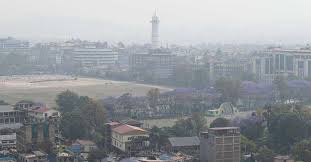KATHMANDU: Nepal’s Ministry of Health and Population has urged people to take precautions as air pollution levels continue to remain unhealthy throughout the week.
The health ministry issued a statement stating that Nepal has recently been listed among the most polluted countries according to the Air Quality Index (AQI). With Kathmandu’s AQI level reaching 348, categorized as ‘hazardous,’ the MoHP advised children, the elderly, pregnant women, and those with chronic illnesses to be especially cautious.
The MoHP has recommended staying indoors unless necessary, wearing masks during travel, and avoiding highly polluted areas.
Ministry Spokesperson Prakash Budhathoki urged “vulnerable groups–children, the elderly, pregnant women, and individuals with respiratory conditions–to exercise heightened caution. The Ministry advises the public to stay indoors unless absolutely necessary, wear masks when venturing outside, and avoid heavily polluted areas.”
The AQI classifies air quality as follows: 0-50 is “good,” 51-100 is “moderate,” 101-150 is “unhealthy for sensitive groups,” 151-200 is “unhealthy,” 201-300 is “very unhealthy,” and above 301 is “hazardous.” Kathmandu’s current AQI stands at 348, placing it firmly in the “hazardous” category.
The National Disaster Risk Reduction and Management Authority attributed the spike in pollution to forest fires, road construction, and industrial activities. It has called on citizens, industries, and construction firms to take proactive steps to curb emissions and safeguard public health. The Authority has also directed relevant agencies to monitor air quality closely and implement urgent measures to mitigate the crisis.
In recent weeks, air pollution in the Kathmandu Valley has worsened significantly, becoming both visible and physically noticeable.
Pollution contains harmful chemicals and fine particulate matter. While larger dust particles are filtered out in the upper respiratory tract, smaller particles, like PM2.5, penetrate deeper into the lungs, leading to asthma, infections, and chronic respiratory conditions. In some cases, this can result in acute asthma attacks, fainting, or dangerously low oxygen levels.
Beyond respiratory issues, air pollution weakens the immune system, making individuals more susceptible to pneumonia and other infections.
Toxic pollutants such as nicotine, cadmium, nitrogen dioxide, and sulfur dioxide enter the bloodstream, affecting vital organs like the heart, kidneys, and brain, and increasing the risk of cancer and paralysis. For pregnant women, high pollution levels pose risks to their unborn children.
During the winter months, cold air traps pollution in the valley, creating a “blanket effect” that prevents proper air circulation. Pollution levels are particularly high in the morning and evening. Seasonal fires, pollution, and urban activities have all contributed to the deterioration of air quality.
The Ministry of Health reports that air pollution causes 42,000 deaths in Nepal annually–19% of which are children under five and 27% are individuals over 70. The data indicates that air pollution has decreased the life expectancy of Nepalis by 4.1%.
Nepal’s air quality is far worse than the World Health Organization’s safe air standards, making this a growing public health crisis.
Meanwhile, the National Disaster Risk Reduction and Management Authority (NDRRMA) has urged relevant sectors to adopt measures to reduce pollution, including proper waste management, dust control during construction, and efforts to control forest fires.
“Citizens have been encouraged to use masks, reduce outdoor activities, and follow health safety measures,” the disaster management authority said in a release. Authorities have attributed the rising pollution to forest fires, road construction, industrial activities, and the increasing heat of the season.


